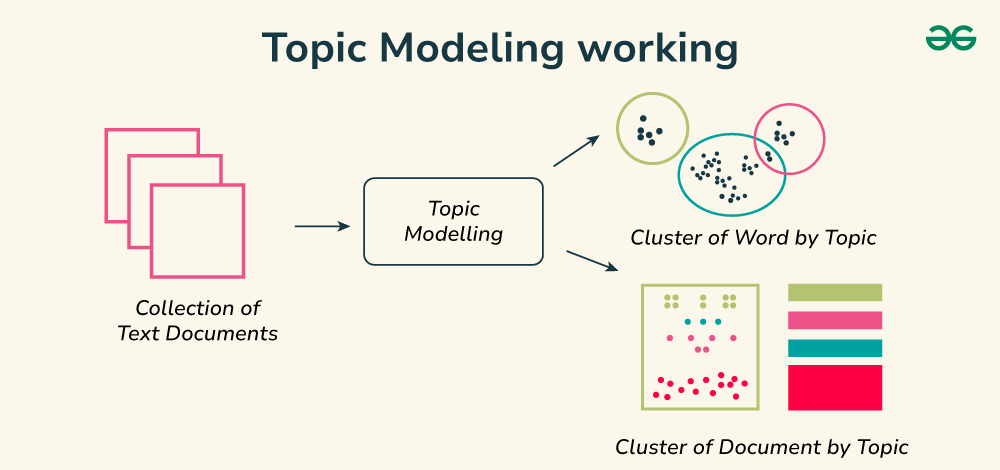
|
|
As the extent and complexity of records continue to grow exponentially, traditional evaluation strategies are falling quickly when it comes to making experience of unstructured information, along with text, snap shots, and audio. This is wherein the importance of advanced analytics techniques, like topic modelling, comes into play. By leveraging sophisticated algorithms, subject matter modelling permits researchers, entrepreneurs, and choice-makers to gain a deeper knowledge of the underlying themes and styles inside considerable troves of unstructured statistics, unlocking treasured insights that may power informed choice-making. 
In this guide, we will understand the meaning of topic modelling and how does this automation works? Table of Content Understanding Topic ModellingTopic modeling is a technique in natural language processing (NLP) and machine learning that aims to uncover latent thematic structures within a collection of texts. Topic modelling is a system learning technique that robotically discovers the principle themes or “topics” that represents a huge collection of documents. The intention of topic modelling is to discover the hidden semantic systems within textual content facts, permitting customers to arrange, apprehend, and summarize the data in a manner that is each green and insightful. At the coronary heart of topic modelling, the concepts of “topics” and “topic models” comes into mind. A ‘topic’ is defined as a recurring pattern of words that best represents a theme within the documents. Topic models are algorithms that scan the document collection to discover these topics. They provide a way to quantify the structure of topics within the text and how these topics are related to each other. Imagine you have a big pile of books, however you don’t know what they may be about. Topic modeling allows you go through them. It seems for words that regularly dangle out together, like “pizza” and “cheese” or “dog” and “bark.” By recognizing these phrase together, subject matter modeling figures out which book is especially speaking about. Importance of Topic ModellingTopic modelling is a powerful text mining approach that allows researchers, businesses, and selection-makers to discover the hidden thematic structures within big collections of unstructured textual content facts. Its importance may be summarized as follows:
In summary, the importance of subject matter modelling lies in its capability to extract significant insights from unstructured records, enhance information enterprise and retrieval, enhance client stories, accelerate studies and discovery, automate repetitive tasks, and allow trend evaluation – all of that may have a large effect on commercial enterprise operations, choice-making, and innovation. How do Topic Modeling Works?Topic modeling work by means of studying the co-occurrence styles of phrases inside a corpus of documents. By identifying the phrases that frequently appear together, the algorithm can infer the latent topics that are gift inside the information. This method is normally performed in an unmanaged way, which means that the model discovers the topics without any prior understanding or labeling of the files. 
Imagine a detective tasked with unraveling a mystery with none prior clues or suspects. Topic modeling operates in a comparable fashion, piecing collectively the narrative hidden in the textual content, guided completely by the subtle cues embedded within the co-incidence patterns of words. Through this unsupervised exploration, the set of rules unveils the underlying shape of the corpus, illuminating the hidden topics and subjects that outline its essence. Types of Topic Modeling TechniquesWhile there are numerous topic modelling techniques to be had, of the most broadly used and properly-mounted techniques are Latent Semantic Analysis (LSA) and Latent Dirichlet Allocation (LDA). Latent Semantic Analysis (LSA)Latent Semantic Analysis (LSA) is a topic modelling method that makes use of a mathematical method known as Singular Value Decomposition (SVD) to identify the underlying semantic standards inside a corpus of text. LSA assumes that there’s an inherent shape in word utilization that may be captured via the relationships between words and documents. The LSA algorithm works via building a term-file matrix, which represents the frequency of every word in each record. It then applies SVD to this matrix, decomposing it into 3 matrices that seize the relationships among phrases, documents, and the latent topics then ensuing topic representations may be used to apprehend the thematic structure of the textual content corpus and to perform duties which include record clustering, records retrieval, and text summarization. Latent Dirichlet Allocation (LDA)Latent Dirichlet Allocation (LDA) is some other extensively used subject matter modelling technique that takes a probabilistic method to discovering the hidden thematic shape of a textual content corpus. Unlike LSA, which makes use of a linear algebraic method, LDA is a generative probabilistic version that assumes each report is a combination of a small number of subjects, and that every word’s creation is as a result of one of the record’s subjects. The LDA algorithm works by means of assuming that each file in the corpus is composed of a combination of subjects, and that each topic is characterised by means of a distribution over the vocabulary. The version then iteratively updates the topic-phrase and report-subject matter distributions to maximise the probability of the found facts. The resulting topic representations can be used to understand the thematic shape of the textual content corpus and to carry out tasks which include file type, advice, and exploratory analysis. LSA vs. LDA : What is the Difference?While both LSA and LDA are effective topic modelling strategies, they range in their underlying assumptions and methodologies.
How Topic Modeling is Implemented?Implementing topic modelling in practice involves several key steps, such as statistics evaluation, preprocessing, and model fitting. For this tutorial we’ll proceed with random generated dataset, and see how can we implement topic modeling. The steps are followed below: Step 1. Data Preparation: The first step in implementing topic modelling is to put together the text documents. This usually entails amassing and organizing the applicable documents, making sure that the records is in a appropriate layout for analysis. Step 2. Preprocessing Steps: Before proceeding to model fitting, it’s far vital to preprocess the textual content to enhance the exceptional of the consequences. Common preprocessing steps include:
Step 3. Creating Document-Term Matrix: After preprocessing the textual content, the following step is to create a document-time matrix, which represents the frequency of every phrase in every report. This matrix serves because the input to the topic modelling algorithms. Step 4: Model Fitting: Once the data is prepared, the next step is to match the topic modelling algorithm to the facts. This includes specifying the number of subjects to be observed and going for walks the algorithm to reap the topic representations.
Applications of Topic ModelingTopic modeling has numerous applications across various fields:
Advantages of Topic Modeling
Challenges in Topic Modeling
ConclusionTopic modelling has emerged as a powerful device for extracting meaningful insights from large and unstructured datasets, records of text information. By uncovering the hidden thematic structures within documents, topic modelling allows researchers, entrepreneurs, and decision-makers to benefit a deeper information of the underlying patterns and trends, ultimately using extra knowledgeable and strategic decision-making. As the volume and complexity of records keep growing, the importance of advanced analytics strategies like subject matter modelling will most effective hold to increase, making it an essential skill for everyone interested by leveraging the electricity of data to pressure innovation and development. |
Reffered: https://www.geeksforgeeks.org
| AI ML DS |
Type: | Geek |
Category: | Coding |
Sub Category: | Tutorial |
Uploaded by: | Admin |
Views: | 16 |